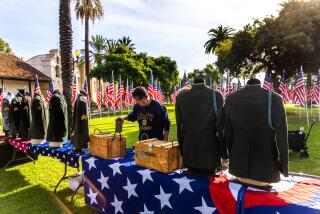Civil War ‘Troops’ Bring History Alive for Students
- Share via
The Civil War came alive Friday in Torrance, as a small troop of Confederate and Union soldiers encamped on the lawn of Towers Elementary School.
The children gathered by grade level every hour to view the soldiers, members of the Ft. Tejon Historical Assn. Clad in clothing from the period, the soldiers showed off their weapons, food rations and bedrolls.
The youngsters listened to an apparent firsthand account of the war by 2nd Lt. Frank Green, commanding officer of Gen. Maxwell Taylor’s Louisiana Brigade, who in his 20th-Century incarnation is a Hawthorne father and inspector at an aerospace company.
In what was their only break with historical accuracy, both Yanks and Rebels obeyed the Confederate commander’s marching orders as they formed a skirmishing line to fire their muskets--albeit with blanks--into neighboring treetops.
“Somebody get that Yankee,” Charles Bott, a member of the 1st Louisiana Special Battalion yelled out before opening fire.
As shots rang out--seemingly in answer--from the Redondo Beach Police Department’s nearby firing range--the scene took on an added touch of realism, and Bott became incredulous: “They’re firing back.”
The demonstration Friday was the group’s second this year at a South Bay school. The members took the day off from work to dramatize a piece of the Civil War, and talk about some of its history.
It is a smaller version of what the group does every third Sunday, April through July, at Ft. Tejon State Historical Park in the Tehachapis, where troops re-enact great battles of the Civil War.
Bott, who has two children at Towers Elementary and organized Friday’s event, said: “Most history is so unanimated, you don’t have anything colorful or interesting, it’s just extremely dry and boring. When the children see us in our uniforms and the weapons, and see us go through our exercises, hopefully that will bring the Civil War to life for them.”
After receiving a brief talk on the war’s history, the students got a taste of a soldier’s life in the 1860s.
They got to look at a Confederate soldier’s three-day food rations, which included coffee beans, salt, brown sugar, salt pork, goober peas (peanuts) and hardtack--a rock hard, flour-and-water biscuit that was typically soaked in coffee before eating.
Green drew laughter each time he relayed a standing joke during the Civil War about the tasteless crackers: “Hey, I bit into something soft. Think it’s a bug?” “Nah, it was just a nail.”
The students also learned that, contrary to popular belief, very few soldiers actually used their bayonets in fighting. “You could dig holes with it, cook over an open fire with it, scratch your back with it or turn it upside down and use it as a candleholder,” Green said. But otherwise, “the bayonet was the most useless device devised by man.”
And many students giggled when he told them how the pup tent got its name: “The first time they set them up, a soldier in one of them barked like a dog. A commanding officer who heard him said, ‘What are those guys doing in those dog tents?’ Soon they were called pup tents, and the name stuck.”
During the question-and-answer periods, children fired a barrage of questions at Green, expressing interest in everything from the weapons to whether Green himself chews tobacco or fought in the war.
“Did they have women fighting in the Civil War?” a first-grade girl asked. (Yes. Some women disguised themselves as men to fight in the war, but most of the women who participated did so as nurses, couriers and messengers.)
“Did we win the war?” A first-grade boy wanted to know.
As Green kneeled to answer him, the children became very quiet. “The country won the war,” Green said. “The country won the war because the results brought us together as one.”
More to Read
Sign up for Essential California
The most important California stories and recommendations in your inbox every morning.
You may occasionally receive promotional content from the Los Angeles Times.













